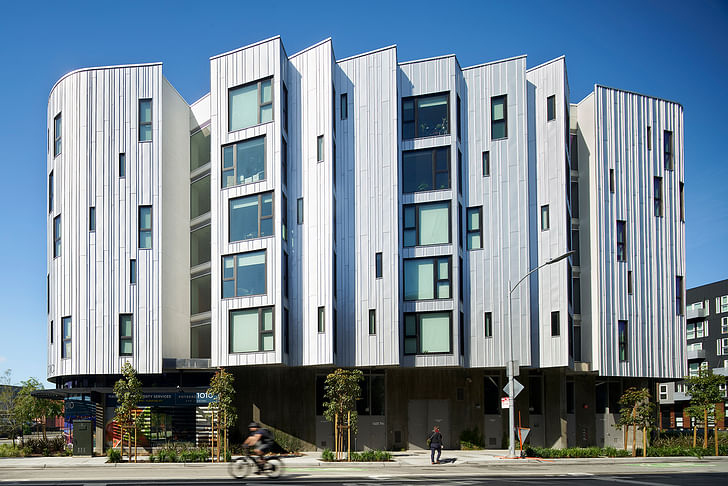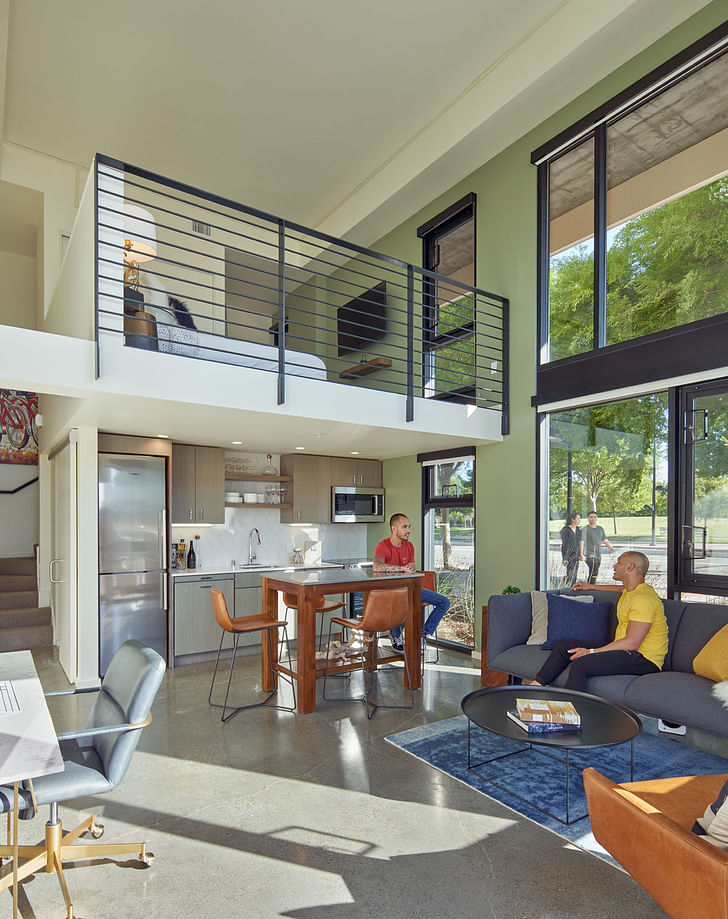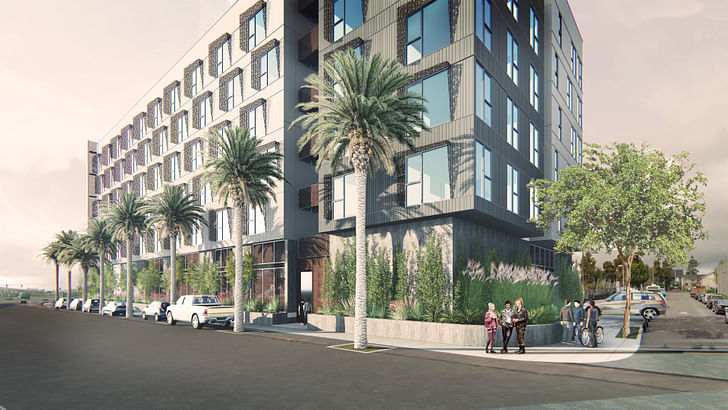

San Francisco's David Baker Architects is a leading office in the realm of affordable housing design. Founded in 1982 by University of California, Berkeley-trained architect David Baker, the firm has designed over 8,000 units of affordable housing across the San Francisco Bay Area, and has garnered hundreds of design awards, including the American Institute of Architects California Council's 2012 Distinguished Practice award.
Baker, who was elevated to the AIA's College of Fellows in 1996, runs the practice with principals Amanda Loper and Daniel Simons. Their work, which spans affordable, senior, workforce, and low-income housing types, is distinctive for the inventive sense of materiality and playful but dignified formal approaches the architects pursue as they go about fulfilling the myriad and sometimes tedious requirements specific to these types of projects. Using this approach, the team strives to concretize their "passion for and deep understanding of the power of humane and respectful environments to transform neighborhoods and elevate the lives of individuals and families."
For this week's Studio Snapshot, David Baker discusses the struggles of striving out on one's own, how DBA's work culture has changed over the years to become more family-friendly, and what new research arenas mean for the practice.
Where and when did your practice start?
I started David Baker Architects in 1982 in Berkeley, California. It was a spinoff from the first company I founded with two classmates while still in architecture school at the University of California, Berkeley in 1978, a solar design consultant firm called Sol Arc.
How did you come up with your name and company ethos?
The name was easy, I'm David Baker.
The first project I took on (no staff!) was an energy-efficient urban housing design for a conservative merchant builder. I survived, and the project won a solar design award. The developer recommended me to Bridge Housing, a nonprofit affordable housing developer that has been a major client ever since.
Over that span of time, we’ve evolved from a hierarchical studio very much headed by me to a collaborative team-based structure. So much better!

How many people work at your company?
We are 38 team members right now.
What made you make the decision to start an office?
My father was self-employed, and I never considered any other way than leading my own firm. I started out in college with my own contracting firm, Gonzo Construction. So DBA was actually my third try.

What are other offices that you look at for guidance and why?
We participate in a firm roundtable with several firms we admire, most notably Miller Hull and Koning Eisenberg Architecture.
What would you want your firm to be known for?
The thoughtful design of wonderful, equitable places that foster community.

What was the first 365 days of running your practice like?
A very steep learning curve with very little financial reward for me. For the first couple of years, my staff made more than me.
What were the biggest obstacles along the way?
Recessions are the biggest obstacles. Sometimes the economy tanked, and we had no work, but we made it through. More generally, I could have been more strategic: I followed various threads in an untidy chaotic way. On the other hand, that led to unanticipated but rewarding places.

What are you currently working on?
We are still focused very much on housing but have grown into taking on new typologies and related areas, such as development proposals at a neighborhood scale and community-based hospitality.
What other avenues of creative exploration does your office pursue?
One of our practice areas is our DBA_LAB, which is where we put our research and pro-bono work. We have also taken on interiors and urban planning.

What are the benefits of having your own practice? And staying small?
I used to say that the benefit of having your own practice is flexibility: you get to choose whichever 60 hours a week you want to work. As we’ve grown more established we’ve scaled that back to a family-friendly culture. But we still get to pursue areas of interest, without answering to an outside owner.
The traditional rule is that the maximum size of a firm that can maintain a family-type culture is around 35. Though modern communication has potentially increased that limit, we’ve consciously attempted to stay in the small, tightly knit firm range. We feel it allows us to keep our edge and intensity.
What is the main thesis of your office and has it changed over time?
We have become much more family-friendly, equitable, and collaboration-oriented over time. We support a reasonable work schedule and culture, and we have a flat structure, meaning people are pretty empowered and responsible for their own work rather than reporting upward or taking orders from above. We find that if people have a good work environment and get to spend quality time with their families and communities, they have more energy, creativity, and focus to bring to their work, not less. Most of our computers are laptops, and we work collaboratively in the cloud, so when people need to, they can work from home or from any of our three offices. And we're accommodating of the things that come up for parents—kid drop-off or pick-up, doctor appointments, closed school days, and so on.
In 2018, we applied for and received the JUST Label, which is a transparency platform for organizations to examine and disclose their operations in areas of diversity, equity, safety, worker benefit, local benefit, and stewardship. We offer pay equity and extensive and flexible parental leave—up to 12 weeks. We have an amazing, creative staff, and we want to keep them happy and in a position to continue the great collaborations we have going. In fact, the initial motivation for opening our southeastern regional office in Birmingham, Alabama, was to support principal Amanda Loper in moving closer to her roots and her family with two young daughters.

Where do you see the office in 5 years? In 10 Years?
We are transitioning to our third generation of leadership. Architectural practice continues to evolve, and we will continue to adapt. Our practice has decentralized to three offices in the past few years, and I think that trend, enabled by new technology, will continue. The diversity of leadership will broaden our practice areas, from custom fabrication to interiors to research to larger-scale planning. But the only thing certain about the future is that your predictions won’t be quite right.
How do you look for talent for your office?
We have an open and supportive office culture, which has helped us attract great talent.

What are some of the spatial differences between designing affordable and market-rate housing projects?
We’ve always taken the approach that affordable housing should pay as much attention to design quality as market-rate housing. So often the differences are subtle, such as fancier appliances in market-rate housing and greater durability in affordable housing.
You have recently experimented with modular construction on your Union Flats project near San Francisco--How did the project benefit from this approach?
The decision to go with modular construction was driven by a funding deadline. Though a work in progress, offsite factory-built construction has the potential for significant construction time and cost savings.

Your office often works with talented landscape architects and urban designers, how do you shape the spaces between buildings in a way that is different from conventional approaches?
I would say that the importance of a talented and collaborative team for any sort of design project cannot be overestimated, particularly the role of the landscape architect. In general, we try to think “outside the property line” to integrate and enhance the urban fabric.
Antonio is a Los Angeles-based writer, designer, and preservationist. He completed the M.Arch I and Master of Preservation Studies programs at Tulane University in 2014, and earned a Bachelor of Arts in Architecture from Washington University in St. Louis in 2010. Antonio has written extensively ...
No Comments
Block this user
Are you sure you want to block this user and hide all related comments throughout the site?
Archinect
This is your first comment on Archinect. Your comment will be visible once approved.